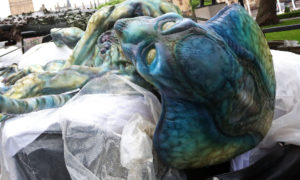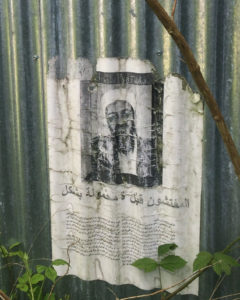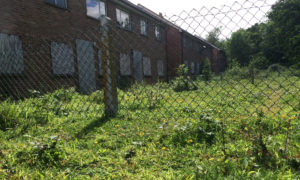Today we continue our series of posts inspired by the People Need Nature expedition to Lodge Hill, Kent.
This one is from the Guardian’s film critic Catherine Shoard, is cleverly disguised as a review of Independence Day: Resurgence.
The CGI monsters of Independence Day will never haunt the imagination

An alien from Independence Day: Resurgence: ‘The beasties inside the planes, as well as the planes themselves, all look the same.’ Photograph: Joe Pepler/REX/Shutterstock
Last Thursday I went to Belfast and Basra. I did this in Kent, at a massive abandoned army camp sold off by the Ministry of Defence and now earmarked for 5,000 new homes. In fact there are already a handful of houses on the site, constructed by the army in the 70s and 80s for bomb disposal and combat reconnaissance training, and now colonised by bee orchids and nightingales.
These houses are in two blocks: a couple of Troubles-era terraces and a smaller stretch given a light Middle Eastern makeover. The first lot were shockingly realistic: Cupar Street, template airlifted straight from Antrim, had lovingly copied murals and eerily accurate back gardens, now lovely and overrun. Peer through the letter boxes and you could see remnants of painstaking set-dressing used to better disguise booby traps. There was even a block of public loos in which explosives could be defused, plus a phone box and dummy cesspit.
The other houses were less immediately impressive. I’ve not been to Iraq or Afghanistan, but I’d be surprised if their roofs shared so much with the semis of Strood. But round the edge, still visible on the corrugated fences, are extraordinary peeling propaganda posters. They displayed fading yet evidently incendiary script, assorted imams and Osama bin Laden, chin tickled by brambles, eyes scraped out – by squaddies or badgers, who knows. Disorienting doesn’t begin to cover it.
These days the comparative training that troops are offered takes place by the river near Gravesend, where the fresh-built estate is just a facade: a backdrop for street combat, not a proper mock-up. Or, more usually, via computer simulations which work a bit like clicking the late braking pram during the hazard awareness section in your driving theory test. Makes sense, of course. After all, bricks and mortar are expensive, and everything’s turning virtual these days. Your mind can be tricked wonderfully with the right software, the right headset, the top goggles.

‘Osama bin Laden, chin tickled by brambles, eyes scraped out – by squaddies or badgers who knows.’ Photograph: Catherine Shoard
In fact you don’t even need those if you can get to a cinema with a screen wide enough and a sound system sufficiently boomy. Take the Independence Day sequel, out this week, which offers the experience of standing beneath a mass extraterrestrial flyby. “That is definitely bigger than the last one,” comments Jeff Goldblum’s scientist at the sight of the mothership; one of the great joys of computer-generated imagery is that enlargement, as well as copying and pasting, costs peanuts.
That, presumably, is why the beasties inside the planes, as well as the planes themselves, all look the same. It does not explain why they all also look like less interesting descendants of the big dribbly antihero from Alien: the one HR Giger constructed from card and goo and inspiration in 1979. To paraphrase Lao Tzu: give a man an old loo roll and a bit of sticky tape and he’ll likely make something great; hand a team limitless cash and kit and it turns out that – sometimes, not always – they’ll just obligingly recycle analogue ideas into something less tangible.
Everyone knows a surfeit of resources can breed a poverty of imagination; a poverty only amplified in widescreen gigantism. Such battering over-provision also threatens to insult both the public and the whole of history.
In the past, art credited its audience with enough imagination to get there themselves, to fill in the gaps. Indeed, it depended on it. Not only do the best horror movies suggest threat and withhold bogeymen rather than shoving them in our face, the written word always relied entirely on huge leaps of imagination, empathy and wonder. While virtual reality apparently hands us the keys to a fantasy land, it actually tends to confiscate them. The scope of our imagination is presupposed, and found lacking. We are rendered as passive as possible. We stumble about, imprisoned by pixels. Such innovation – whether we are watching a 3D film, playing a first-person game or using a simulator to train us for work that depends on intricate experience – also underestimates the extent to which environment affects us. Yet this is always hard to anticipate, let alone program. Some things simply can’t be captured and repackaged in this way. You’re only there when you’re there.
You are not meant to take souvenirs from ex-MoD sites. But Chattenden barracks will likely soon be razed, so I did, I’m afraid: a fired blank, an alarming see-through shield (“Warning: disconnect mains supply before removing cover”) and a small lump of plastic, once presumably molten and now solidified into an arty pat.
Nobody wants a Potemkin village. But deceptions built of straw are at least propped up with something. They are physical things that exist in the same space as us. They are made of molecules, like us. Matter matters. We need to remember what it feels like.


Comments are closed.